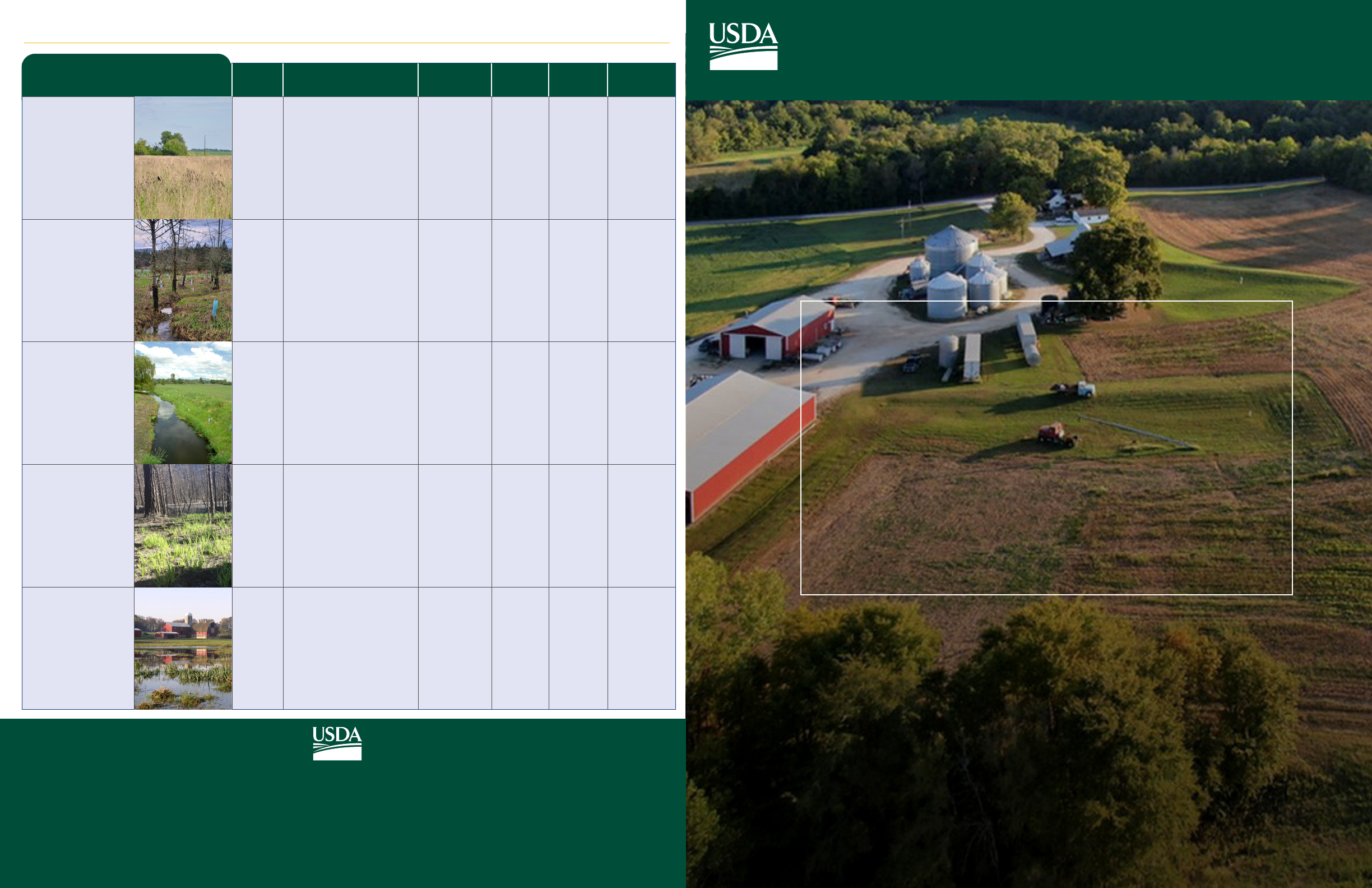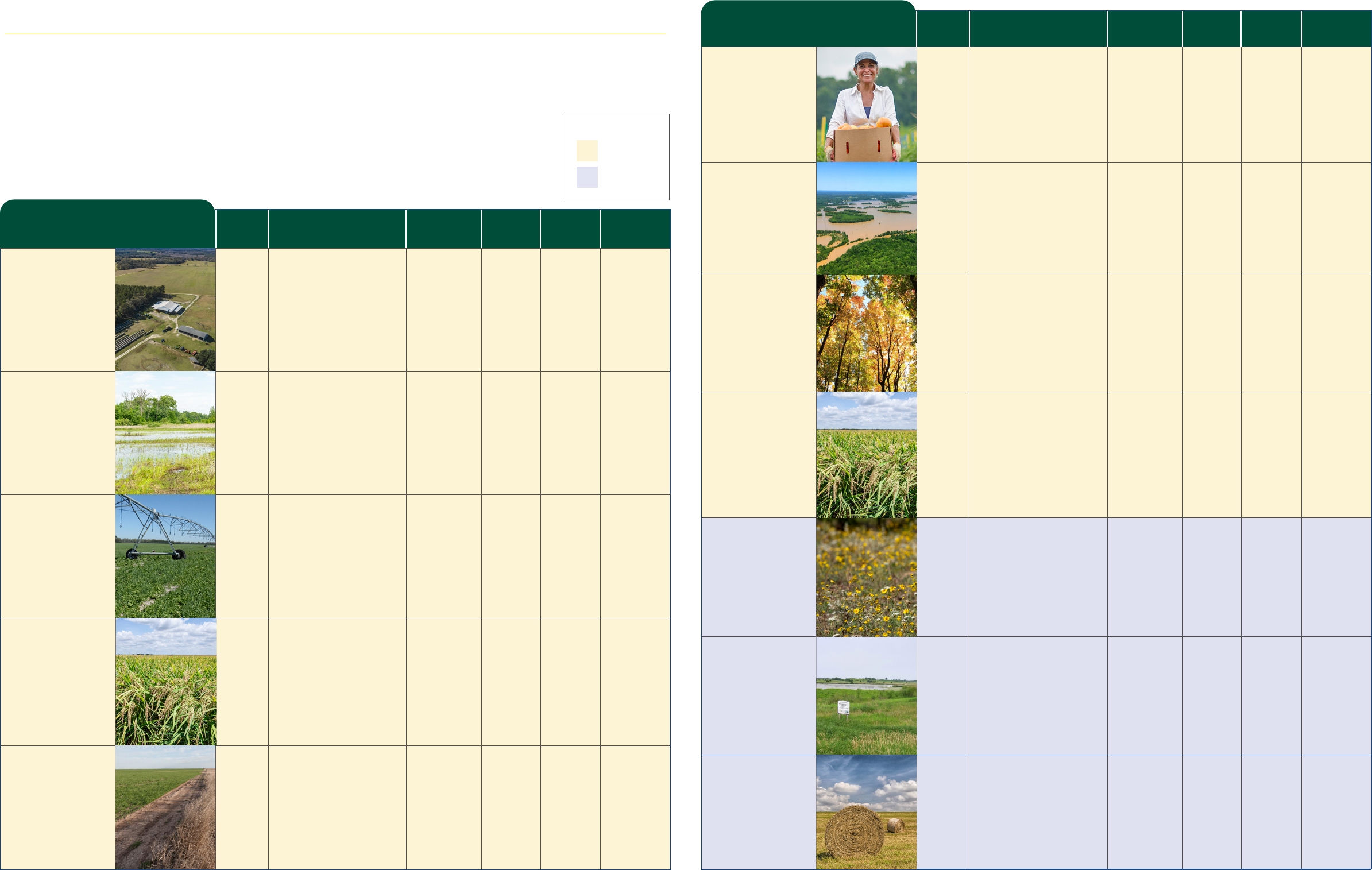
CONSERVATION
PROGRAMS
AT A GLANCE
United States
Department of
Agriculture
USDA is an equal opportunity provider, employer, and lender.
CONSERVATION
PROGRAM
AGENCY DESCRIPTION
APPLICABLE
LAND USES
CONTRACT
LENGTH
ELIGIBILITY NOTES
GRASSLAND
CRP SIGNUP
FSA A voluntary program that
contracts with agricultural
producers to help landowners
and operators protect
grassland. The program
emphasizes support for grazing
operaons, plant and animal
biodiversity, and eligible land
containing shrubs and forbs
under the greatest threat of
conversion.
Grasslands,
Rangeland,
Pastureland
10 - 15
years
Control land
for contract
term
Haying &
grazing
allowed
w/some
restricons
CONSERVATION
RESERVE
ENHANCEMENT
PROGRAM
(CREP)
FSA Targets specic state or naonally
signicant conservaon concerns.
Federal funds are supplemented
with non-federal funds to
address those concerns by paying
farmers in exchange for removing
environmentally sensive land
from producon and establishing
permanent resource conserving
plant species.
Cropland or
pasture
15 years Control land
for contract
term
Restricons
are negoated
with the
partner and
are specic
to each
agreement.
EMERGENCY
CONSERVATION
PROGRAM
(ECP)
FSA Provides funding and technical
assistance for farmers and
ranchers to restore farmland
damaged by natural disasters
and for emergency water
conservaon measures in
severe droughts.
Previously
farmed
wetlands or
wetland buers
10-15 years Must
have been
used for
agricultural
purposes for
three of the
past 10 crop
years
Land cannot
be used for
commercial
purposes
EMERGENCY
FOREST
RESTORATION
PROGRAM
(EFRP)
FSA Provides funding to restore
privately owned forests
damaged by natural disasters.
Assistance helps landowners
carry out emergency measures
to restore forest health on land
damaged by oods, hurricanes
or other natural disasters.
Private
forestland
damaged by a
natural disaster
Disaster-
specic
funding
FSA County
Commiee
inspects the
damage to
determine
if land is
eligible
Only owners of
nonindustrial
private forests
with tree
cover exisng
before the
natural disaster
occurred are
eligible.
FARMABLE
WETLANDS
PROGRAM
(FWP)
FSA Designed to restore previously
farmed wetlands and wetland
buer to improve both
vegetaon and water ow.
Parcipants must agree to
restore the wetlands and
establish plant cover. Plant
cover may include plants that
are parally submerged or
specic types of trees.
Previously
farmed
wetlands or
wetland buers
10-15 years Must
have been
used for
agricultural
purposes for
three of the
past 10 crop
years
Land cannot
be used for
commercial
purposes
CONSERVATION PROGRAMS AT A GLANCE
UNITED STATES DEPARTMENT OF AGRICULTURE
United States
Department of
Agriculture
FARM PRODUCTION AND CONSERVATION
FARM SERVICE AGENCY (FSA) | NATURAL RESOURCES CONSERVATION SERVICE (NRCS) | RISK MANAGEMENT AGENCY (RMA)
More Informaon
For more informaon about USDA conservaon programs, visit farmers.gov/conservaon
or contact your local USDA Service Center.
To nd your local USDA Service Center, visit farmers.gov/service-locator.

USDA’s Natural Resources Conservaon Service (NRCS) and Farm Service
Agency (FSA) oer federally funded, voluntary conservaon programs to
help farmers, ranchers, and private forest landowners protect and conserve
the natural resources we all depend on, supporng healthy soil, cleaner air
and water, and conserving wildlife habitats, while helping to migate the
impacts of climate change.
NRCS and FSA conservaon programs are incenve based and provide
nancial assistance to implement conservaon pracces. NRCS also oers
free conservaon technical assistance to help producers plan pracces.
NRCS accepts applicaons for conservaon programs year-round, but
applicaons are ranked and funded by funding cycle, which have state-
specic applicaon dates.
FSA program applicaon periods vary by program. Producers interested in
assistance are encouraged to contact their local USDA Service Center.
In addion to NRCS and FSA conservaon programs, USDA’s Risk
Management Agency (RMA) also supports conservaon through
Federal crop insurance, including supporng use of cover crops, water
conservaon, and nutrient management.
To parcipate in FSA and NRCS programs,
producers have to be compliant with adjusted
gross income requirements as well as highly
erodible soils and wetland provisions.
Addionally, other eligibility provisions may apply.
CONSERVATION PROGRAMS AT A GLANCE
CONSERVATION
PROGRAM
AGENCY DESCRIPTION
APPLICABLE
LAND USES
CONTRACT
LENGTH
ELIGIBILITY NOTES
ACEP-
AGRICULTURAL
LAND EASEMENTS
(ALE)
NRCS Helps private and tribal
landowners, land trusts, and
other enes such as state
and local governments protect
croplands and grasslands on
working farms and ranches by
liming non-agricultural uses of
the land through conservaon
easements.
Cropland,
pasture, forest
Permanent Apply to
local enty
Apply through
partner
ACEP-WETLANDS
RESERVE
EASEMENTS
(WRE)
NRCS Helps private and tribal
landowners protect, restore,
and enhance wetlands which
have been previously degraded
due to agricultural uses.
Cropland,
pasture, forest
and non-ag land
30 years or
Permanent
Landowner
and
landscape
requirements
2-year
ownership
prior to
applicaon
Apply directly
to NRCS
AGRICULTURAL
MANAGEMENT
ASSISTANCE
(AMA)
NRCS Helps agricultural producers
manage nancial risk through
diversicaon, markeng, or
natural resource conservaon
pracces. NRCS administers the
conservaon provisions while
USDA’s Agricultural Markeng
Service and RMA implement
the producon diversicaon
and markeng provisions.
Cropland,
pasture, forest,
farmstead and
associated ag.
land
Up to 10
years
Control land
for contract
term
Not available
in every state
CONSERVATION
INNOVATION
GRANTS (CIG)
NRCS Compeve program that
supports the development of
new tools, approaches, pracces,
and technologies to further
natural resource conservaon on
private lands. Through creave
problem solving and innovaon,
CIG partners work to address our
naon's water quality, air quality,
soil health, and wildlife habitat
challenges, all while improving
agricultural operaons.
Cropland,
pasture, forest,
farmstead, and
associated ag.
land
1-3 years Classic: All
non-Federal
enes and
individuals
are eligible
to apply.
On-Farm
Trials: All
non-Federal
enes are
eligible to
apply.
All CIG
projects
must involve
EQIP-eligible
producers
CONSERVATION
STEWARDSHIP
PROGRAM
(CSP)
NRCS Helps agricultural producers
maintain and improve
their exisng conservaon
systems and adopt addional
conservaon acvies to
address priority natural
resource concerns. The higher
the performance above exisng
management, the higher the
payment.
Cropland,
pasture, forest,
farmstead and
associated ag.
land
5 years Control land
for contract
term
Meet
stewardship
thresholds
CONSERVATION
PROGRAM
AGENCY DESCRIPTION
APPLICABLE
LAND USES
CONTRACT
LENGTH
ELIGIBILITY NOTES
ENVIRONMENTAL
QUALITY
INCENTIVES
PROGRAM
(EQIP)
NRCS
NRCS’s agship conservaon
program provides nancial and
technical assistance to agricultural
producers to address natural
resource concerns and deliver
environmental benets, such as
improved water and air quality,
conserved ground and surface
water, reduced soil erosion and
sedimentaon, and improved or
created wildlife habitat.
Cropland,
pasture, forest,
farmstead and
associated
agricultural land
1 - 10 years Control land
for pracce
lifespan
No payment
duplicaon
EMERGENCY
WATERSHED
PROTECTION
PROGRAM
NRCS Assists sponsors and
landowners to protect lives
and property from ooding
or soil erosion aer a natural
disaster impairs a watershed.
The EWP Program is designed
for emergency recovery work,
including the purchase of
oodplain easements.
All Variable
Measures
must provide
protecon
from
addional
ooding or
soil erosion
and reduce
threats to life
or property
NRCS will
not provide
funding for
acvies
undertaken
prior to the
signing of
a formal
agreement
HEALTHY
FORESTS RESERVE
PROGRAM
(HFRP)
NRCS Helps landowners restore,
enhance, and protect forestland
resources on private lands
through easements and
nancial assistance. Through
HFRP, landowners promote
the recovery of endangered or
threatened species, improve
plant and animal biodiversity,
and enhance carbon
sequestraon.
Forestland 10-year
restoraon
agreements
and 30-
year or
permanent
easements
Control land
for contract
term
Must be
privately
owned
Apply directly
to NRCS
REGIONAL
CONSERVATION
PARTNERSHIP
PROGRAM (RCPP)
NRCS A partner-driven approach
to conservaon that funds
soluons to natural resource
challenges on agricultural
land. By leveraging collecve
resources and collaborang on
common goals, RCPP Classic
and RCPP Alternave Funding
Arrangements demonstrate
the power of public-private
partnerships in delivering results
for agriculture and conservaon.
Cropland,
pasture, forest,
farmstead, and
associated ag.
land
Typically
ve years
Organizaons
interested in
partnering
with NRCS on
conservaon
projects
submit
project
proposals
during
applicaon
periods.
All RCPP
projects must
develop and
report on their
environmental
outcomes
Producers
can apply to
parcipate in a
funded project
through NRCS
or partners.
GENERAL
CONSERVATION
RESERVE
PROGRAM
(CRP)
FSA Protects soil, water quality,
and habitat by removing highly
erodible or environmentally
sensive land from agricultural
producon through long-
term rental agreements. CRP
landowners are eligible for the
Transion Incenves Program
(TIP), which assists with selling
your land to beginning and
socially disadvantaged farmers.
Cropland 10 - 15
years
Control land
for contract
term
Land cannot
be farmed
CONTINUOUS
CONSERVATION
RESERVE
PROGRAM
(CRP)
FSA Under connuous CRP signup,
environmentally sensive land
devoted to certain conservaon
pracces can be enrolled in
CRP at any me. Also includes
CLEAR30 and Safe Acres for
Wildlife Enhancement (SAFE).
Cropland or
pasture
10 - 15
years
Control land
for contract
term
Land cannot
be farmed
CRP HAYING
& GRAZING
(EMERGENCY &
NON-EMERGENCY)
FSA Haying and grazing of CRP
acres is authorized under
certain condions to improve
the quality and performance of
the CRP cover (non-emergency)
or to provide relief to livestock
producers due to certain natural
disasters (emergency).
Cropland or
pasture
Authorized
pracces
within
the 10 to
15-year
contract
Emergency
- County
designated
severe drought
(D2) or greater
Non-
Emergency
haying every
3 year; grazing
every 2 years.
Haying and
grazing
restricon
apply during
and outside
of the primary
nesng
season.
PROGRAM KEY
NRCS
FSA
